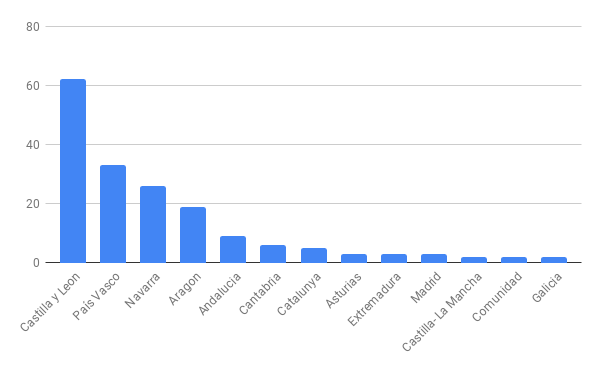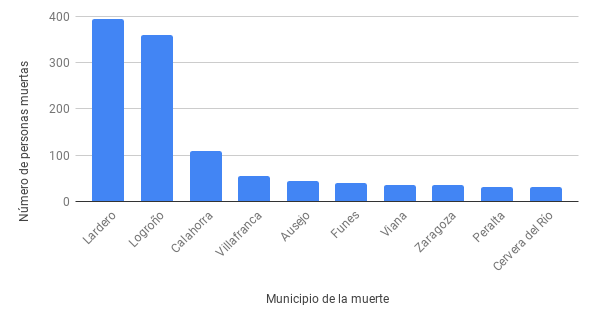

Our database has recently grown with the addition of a dataset which is very special because it includes data about all of the people killed in an entire autonomous community, that of La Rioja. For this we are grateful for the generosity of Jesús Vicente Aguirre, who has contributed the data gathered in his three-volume study, which began under the title Aquí nunca pasó nada. La Rioja, 1936 (Editorial Ochoa, Logroño). In this work of over one thousand pages he summarizes the events, village by village, with names, personal records, documents and, wherever possible, photographs, of the two thousand people killed in La Rioja, most of them between the months of July and December 1936. The entire work is based on extensive documentation and oral testimony. His study is of particular importance because La Rioja was not at any time in a war zone, having fallen into the hands of the military rebels within hours of the military coup of 18 July 1936.
His study covers both people born in La Rioja and residents of the province born elsewhere; it includes not only those killed in the province but also those who died at the battlefront “the great majority of them in the ranks of the national army [ie the Francoist army], in which it was their fate to serve (in most cases merely because of where they were living, though some of them due to their right-wing convictions, while others were attempting to escape the fate for which they had already been identified by their past republican or left-wing sympathies,” in the words of Jesús Vicente Aguirre. Also included are those people from La Rioja who died in the Republican rearguard, obviously while in other provinces, and those deported to the Nazi camps.
We should always remember that behind every item of data there is a person and a family. We should also bear in mind the contrast between the official account of these events and the reality. The photo which illustrates this article shows a scene from a military ceremony in Logroño, the provincial capital of La Rioja, on 2 October 1938 at which Franco decorated the Italian Legionary troops which, along with the German forces, made such an important contribution to the triumph in the Civil War of the forces which had provoked the outbreak of the conflict with their attempted coup d’etat in July 1936. By October 1938, when –as seen in the photo– Franco’s daughter, Carmencita, was hanging decorations on a banner, in La Rioja alone 1,966 people had already been killed, the majority of them victims of the fierce repression. It is important to remember that in La Rioja there had been very little fighting during the Civil War because Gen Mola’s troops entered Logroño on 19 July 1936, shortly after the attempted military coup.

Statistical analysis of the data reveals that in La Rioja the number of women killed was 43, a small percentage (2%) of the total number. 96% of the victims were residents of La Rioja; only 82 people were non-residents – 56 of them from Navarra and 16 from Burgos. In 30% of cases the data indicate where people had been born.
Although the majority of the victims had been born in La Rioja, of the 175 victims living in the province known to have been born elsewhere, 62 were natives of Castilla y León, 33 were from the Basque Provinces and, for example, five were from Catalunya.

With regard to the places where death occurred Innovation and Human Rights has categorised by municipality the 2,006 people who were either born in La Rioja or who were residents of the province born elsewhere. 394 people are recorded as having been thrown into the mass grave of La Barranca, converted into a Civil Cemetery in 1979. This is situated in the municipality Lardero, seven kilometres south of Logroño, where the victims were taken “from September 1936” according to Aguirre “because by then there was no room in the cemetery of Logroño.” In other municipalities we know of the existence of mass graves, as in Logroño (La Grajera), Calahorra (Cuesta de la Gata) and Villafranca Montes de Oca (La Pedraja), amongst many others. From the data available, there are 108 people whose place of death is unknown and, in 164 cases, it has been impossible to distinguish the municipality because the place referred to is larger than one individual municipality.

The research carried out by Jesús Vicente Aguirre also lists the names of the 21 natives of La Rioja who were members of the so-called Tercio Sanjurjo who were murdered in Zaragoza and the six who died as a result of the escape from the prison of Fuerte de San Cristóbal in Pamplona, carried out by 795 prisoners in May 1938. During the escape “207 men were murdered by military forces, members of the Falange [the Francoist official party], requetés [members of the Carlist forces] and irregular forces including people from the surrounding villages, who climbed the hills with their shotguns and their dogs as though they were going on a hunting party” in the words of the researcher Koldo Pla. The mass grave where their bodies were thrown was only discovered last year.
The past 12 months have been special for this non-profit Innovation and Human Rights. We recently marked two and half years since our foundation on 10 December 2016, a date chosen to coincide with the International Day of Human Rights. Shortly before the first anniversary of our establishment, in November 2017, we published our online central database of victims of the Spanish Civil War and the Franco regime which then included over 200,000 individual case files backed by reference to archives and historical research. If you follow this link you can see the presentation which took place in the Centre de Cultura Contemporània de Barcelona (CCCB). During our second year we fully exceeded our objective which had been to double the number of individual case files included in the database; the number now stands at over 700,000 individual case files.
The data base allows you to search for people (by first name and family names); each finding is accompanied by a description of the dataset from which we have obtained the information, along with the author(s) of the research, which may consist of an archive, a book, a thesis….We will be including new datasets in the near future.
Photograph: Military celebration to mark the award of decorations by Franco to the troops of the Italian Legion. Carmencita Franco adding decorations to a banner. Source: Biblioteca Digital Hispánica. Biblioteca Nacional de España
